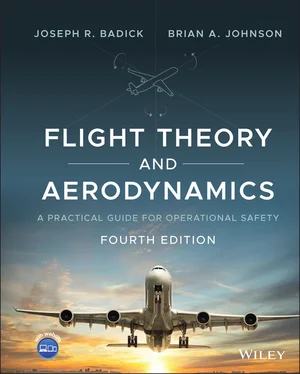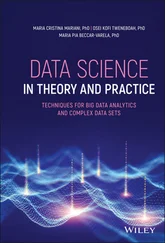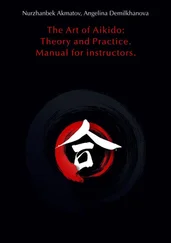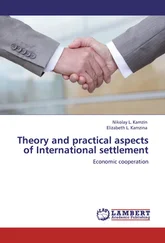Joseph R. Badick - Flight Theory and Aerodynamics
Здесь есть возможность читать онлайн «Joseph R. Badick - Flight Theory and Aerodynamics» — ознакомительный отрывок электронной книги совершенно бесплатно, а после прочтения отрывка купить полную версию. В некоторых случаях можно слушать аудио, скачать через торрент в формате fb2 и присутствует краткое содержание. Жанр: unrecognised, на английском языке. Описание произведения, (предисловие) а так же отзывы посетителей доступны на портале библиотеки ЛибКат.
- Название:Flight Theory and Aerodynamics
- Автор:
- Жанр:
- Год:неизвестен
- ISBN:нет данных
- Рейтинг книги:4 / 5. Голосов: 1
-
Избранное:Добавить в избранное
- Отзывы:
-
Ваша оценка:
- 80
- 1
- 2
- 3
- 4
- 5
Flight Theory and Aerodynamics: краткое содержание, описание и аннотация
Предлагаем к чтению аннотацию, описание, краткое содержание или предисловие (зависит от того, что написал сам автор книги «Flight Theory and Aerodynamics»). Если вы не нашли необходимую информацию о книге — напишите в комментариях, мы постараемся отыскать её.
AERODYNAMICS
GET A PILOT’S PERSPECTIVE ON FLIGHT AERODYNAMICS FROM THE MOST UP-TO-DATE EDITION OF A CLASSIC TEXT Flight Theory and Aerodynamics
Flight Theory and Aerodynamics
Flight Theory and Aerodynamics
Flight Theory and Aerodynamics — читать онлайн ознакомительный отрывок
Ниже представлен текст книги, разбитый по страницам. Система сохранения места последней прочитанной страницы, позволяет с удобством читать онлайн бесплатно книгу «Flight Theory and Aerodynamics», без необходимости каждый раз заново искать на чём Вы остановились. Поставьте закладку, и сможете в любой момент перейти на страницу, на которой закончили чтение.
Интервал:
Закладка:
13 Chapter 13Figure 13.1 (a) Negative yawing moment, (b) positive yawing moment.Figure 13.2 (a) Unstable, (b) stable in yaw.Figure 13.3 Static directional stability.Figure 13.4 Static directional stability at high sideslip angles.Figure 13.5 Effect of wing sweepback on directional stability.Figure 13.6 Directional instability of fuselage.Figure 13.7 Vertical tail is stabilizing in yaw.Figure 13.8 Dorsal fin decreases drag and increases stability.Figure 13.9 Typical buildup of component effects on static directional stabi...Figure 13.10 Rudder‐fixed–rudder‐free yaw stability.Figure 13.11 Loss of directional stability at high AOA.Figure 13.12 Slipstream rotation causes yaw.Figure 13.13 Asymmetrical loading.Figure 13.14 Yawing moment due to asymmetrical thrust.Figure 13.15 Yawing moment due to critical engine.Figure 13.16 Comparison of forward slip to sideslip.Figure 13.17 Propeller drag contribution.Figure 13.18 Effect of rearward CG on yaw.Figure 13.19 Relationship of V MCto V S.Figure 13.20 Rolling moment caused by sideslip.Figure 13.21 (a) Stable, (b) neutral, and (c) unstable static lateral stabil...Figure 13.22 Static lateral stability.Figure 13.23 Dihedral angle.Figure 13.24 Dihedral producing static lateral stability.Figure 13.25 Dihedral effect of sweepback.Figure 13.26 NASA X‐29 aerodynamic features.Figure 13.27 Vertical tail effect on lateral stability.Figure 13.28 Adverse yaw.Figure 13.29 High AOA: (a) upgoing wing: (b) downgoing wing.Figure 13.30 Coupled ailerons and rudder.Figure 13.31 Yaw damper impact on Dutch roll characteristics.Figure 13.32 Flight paths due to coupled dynamic effects: (a) spiral diverge...
14 Chapter 14Figure 14.1 (a) Subsonic flow, (b) supersonic flow.Figure 14.2 Airflow over a wing section.Figure 14.3 Comparison of supercritical and laminar flow airfoils at Mach 0....Figure 14.4 Effect of wing sweep on a C L− α curve.Figure 14.5 Vortex generators.Figure 14.6 High‐speed subsonic flight control surfaces.Figure 14.7 Force divergence effect on C D.Figure 14.8 Force divergence effect on C L.Figure 14.9 Normal shock wave on bottom of wing.Figure 14.10 Aerodynamic center location shift.Figure 14.11 Stick forces versus Mach number.Figure 14.12 Normal shock waves move to trailing edge.Figure 14.13 Unattached bow wave at transonic speed.Figure 14.14 Formation of an oblique shock wave.Figure 14.15 Formation of an expansion wave.Figure 14.16 Summary of supersonic wave characteristics.Figure 14.17 Double‐wedge airfoil in supersonic airflow: (a) wave pattern, (...Figure 14.18 Double‐wedge airfoil developing lift: (a) wave pattern, (b) pre...Figure 14.19 Circular arc airfoil in supersonic flow: (a) wave pattern, (b) ...Figure 14.20 Effect of wing sweep on C D.Figure 14.21 Mach cone.Figure 14.22 Swept wing in supersonic flight.Figure 14.23 The area rule. (a) Cigar shaped fuselage (b) Waisted fuselage....Figure 14.24 Subsonic control surface.Figure 14.25 Supersonic control surface.Figure 14.26 Normal shock engine inlet.Figure 14.27 “Spike” oblique shock engine inlets.Figure 14.28 Stagnation temperatures.Figure 14.29 Effect of temperature on tensile strength of metals after half‐...
15 Chapter 15Figure 15.1 Momentum theory airflow: (a) schematic, (b) pressure and velocit...Figure 15.2 NACA 0012 airfoil.Figure 15.3 Location of critical forces on an airfoil.Figure 15.4 Centrifugal force straightens rotor blade.Figure 15.5 Lift force and centrifugal force.Figure 15.6 Resultant of lift and centrifugal forces.Figure 15.7 Forces acting on a lifting blade.Figure 15.8 Entire lifting rotor system.Figure 15.9 Hovering helicopter at light weight.Figure 15.10 Hovering helicopter at heavy weight.Figure 15.11 Forward flight forces.Figure 15.12 Lift component of 10 000‐lb total thrust at 15°.Figure 15.13 Rotor velocity distribution in hover.Figure 15.14 Lift distribution on a twisted/untwisted blade.Figure 15.15 Hovering out of ground effect.Figure 15.16 Hovering in ground effect.Figure 15.17 Antitorque rotor.Figure 15.18 Correction for antitorque rotor drift.Figure 15.19 Rigid rotor system.Figure 15.20 Semirigid rotor system.Figure 15.21 Articulated rotor system.Figure 15.22 Rotor tip velocities in a hover.Figure 15.23 Blade‐tip velocity in forward flight.Figure 15.24 Rigid rotor rolling moment in forward flight.Figure 15.25 Angle of attack and flight path changes: (a) advancing blade, (...Figure 15.26 CG radius change with flapping motion.Figure 15.27 Hunting motion of a fully articulated blade.Figure 15.28 AOA distribution during a retreating blade stall.Figure 15.29 Gyroscopic precession.Figure 15.30 Swash plate schematic.Figure 15.31 Rotor flapping caused by cyclic stick movement.Figure 15.32 Tail rotor dissymmetry of lift.Figure 15.33 Helicopter power available and power required.Figure 15.34 Running/rolling takeoff.Figure 15.35 Vortex ring state.Figure 15.36 Height/velocity diagram.Figure 15.37 Induced flow velocity in a hover.Figure 15.38 Airflow and force vectors in forward flight.Figure 15.39 Airflow and forces in steady‐state descent.Figure 15.40 Airflow and forces during autorotative flare.
Guide
1 Cover Page
2 Title Page
3 Copyright Page
4 Preface
5 About the Authors
6 About the Companion Website
7 Table of Contents
8 Begin Reading
9 Answers to Problems
10 Bibliography
11 Index
12 Wiley End User License Agreement
Pages
1 iii
2 iv
3 xi
4 xiii
5 xiv
6 xv
7 xv
8 1
9 2
10 3
11 4
12 5
13 6
14 7
15 8
16 9
17 10
18 11
19 12
20 13
21 14
22 15
23 16
24 17
25 19
26 20
27 21
28 22
29 23
30 24
31 25
32 26
33 27
34 28
35 29
36 30
37 31
38 32
39 33
40 34
41 35
42 36
43 37
44 38
45 39
46 40
47 41
48 42
49 43
50 44
51 45
52 46
53 47
54 48
55 49
56 50
57 51
58 52
59 53
60 54
61 55
62 56
63 57
64 58
65 59
66 60
67 61
68 62
69 63
70 64
71 65
72 66
73 67
74 69
75 70
76 71
77 72
78 73
79 74
80 75
81 76
82 77
83 78
84 79
85 80
86 81
87 82
88 83
89 84
90 85
91 86
92 87
93 88
94 89
95 90
96 91
97 92
98 93
99 94
100 95
101 97
102 98
103 99
104 100
105 101
106 102
107 103
108 104
109 105
110 106
111 107
112 108
113 109
114 110
115 111
116 112
117 113
118 114
119 115
120 116
121 117
122 118
123 119
124 120
125 121
126 122
127 123
128 124
129 125
130 126
131 127
132 128
133 129
134 130
135 131
136 132
137 133
138 134
139 135
140 136
141 137
142 138
143 139
144 140
145 141
146 142
147 143
148 144
149 145
150 146
151 147
152 148
153 149
154 150
155 151
156 152
157 153
158 154
159 155
160 156
161 157
162 158
163 159
164 160
165 161
166 162
167 163
168 164
169 165
170 166
171 167
172 168
173 169
174 170
175 171
176 172
177 173
178 174
179 175
180 176
181 177
182 178
183 179
184 180
185 181
186 182
187 183
188 184
189 185
Читать дальшеИнтервал:
Закладка:
Похожие книги на «Flight Theory and Aerodynamics»
Представляем Вашему вниманию похожие книги на «Flight Theory and Aerodynamics» списком для выбора. Мы отобрали схожую по названию и смыслу литературу в надежде предоставить читателям больше вариантов отыскать новые, интересные, ещё непрочитанные произведения.
Обсуждение, отзывы о книге «Flight Theory and Aerodynamics» и просто собственные мнения читателей. Оставьте ваши комментарии, напишите, что Вы думаете о произведении, его смысле или главных героях. Укажите что конкретно понравилось, а что нет, и почему Вы так считаете.












